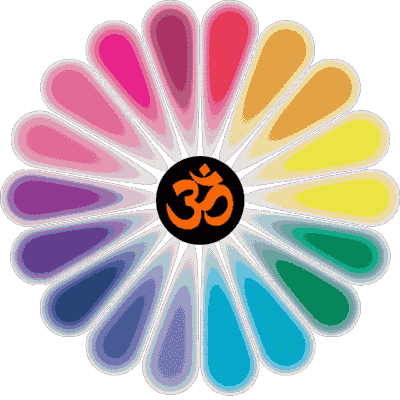Donation Form
Please fill in the following details to Donate:-
Thank you, we appreciate your support.
"Note: - Permanent Account Number (PAN) is mandatory for Donation above Rs.2,000 /= ."
Donation Form
Please fill in the following details to Donate:-
Thankyou we appreciate your support. our representative will contact you shortly
Jagadguru SRI ADI SHANKARACHARYA
ABOUT Jagadguru SRI ADI SHANKARACHARYA
| Year of Birth : 788 AD | Place of Birth : Kaladi, Kerala, India |
| Father : Sri.Shivaguru | Mother : Aryamba |
| Teacher/Guru : Sri Govinda Bhagavatpada | Disciples : Sri.Padmapada, Sri.Totakacharya, Sri.HastaMalaka, Sri.Sureshvaracharya |
| Philosophy : Advaita Vedanta | Consolidated & Doctrine of : Dashanami Sampradaya, Advaita Vedanta |
| Year of Mukthi : 820 AD | Place of Death : Kedarnath, Uttarakhand, India |
In Kaladi, Kerala, a learned brahmin, by name Shivaguru, and his wife, Aryamba. This childless couple performed puja for 48 days to Lord Shiva and prayed for a son. Lord Shiva melted in their devotion and appeared before them and told them "I am extremely happy with your devotion and you will get what you want. But tell me whether you want a number of dull children or a son who is extremely intelligent, who will live for a short period only." The couple replied the decision could not be theirs as the Lord knows what is good for them. Lord Shiva, pleased with the reply, was born to Aryamba . As the Lord had already promised that he will be born to do good to this world, the child was named Shankara. Sam means mangala and Karathi means the doer. As Shankara grew up, he attracted everybody with his intelligence and kindness. At the age of three, he was given "Aksharabyas", i.e., the learning of writing and reading. At the age of four, he lost his father. At the age of five, he was initiated in Brahmacharya i.e., the holy thread ceremony was conducted, and he was sent to Gurukul for learning of scriptures. As per the practice the brahmacharihas to go from house to house and take alms and submit this to his guru.

On a Dwadasi day Shankara happened to go to the house of a very poor lady and asked for the alms. The lady did not have a single grain of rice in her house to give. However she had kept a single Amla fruit for herself as it was a Dwadasi day. She unhesitatingly gave this Amla fruit to Shankara as she could not send a Brahmachari empty handed. Shankara was moved by her selflessness and the poverty of the lady and prayed Goddess Lakshmi in a beautiful sloka which is called "Kanaka DharaStotram". On completion of this stotram, Goddess Lakshmi appeared in person and showered a rain of golden coins in the poor lady's house. Shankara was very bright and brilliant right from his childhood & he was inclined towards sanyasa right from his childhood. One day, the rishis came to him and reminded him of his duty to revive the world by spreading spiritualism &Shankara agreed to become a Sanyasi. One day when Shankara was taking bath, a crocodile caught hold of his leg. Shankara called out to his mother. Aryamba in the poorna river, came running and to her horror she found her son in the grip of the crocodile and she cried that she did not know how to help her son. Sri Shankara informed his mother that his life was nearing to an end, but if he became a Sanyasi, he could start a new life as a sanyasi. Thus, Sri Shankara obtained permission from his mother to become a sannyasi. Shankara at the tender age of eight, burning with the desire for Liberation, left home went in search of a Guru to be formally initiated as a Sannyasi. The young Shankara walked about 2000 kilometers— to the banks of the river Narmada, in the central plains of India in search of Guru. At the banks of the river Narmada, he found the river gushing forth into floods. By using his powers, he encapsulated the river in his Kamandal (a vessel sannyasi's carry) and released it in the banks of the river. Sri GovindapadaBagawathpada, an ascetic who saw this, marvelled at Sri Shankara took him on as a Shishya. Sri GovindaBagawathpada taught various vedas to Sri Shankara. He also taught about Advaita, the principle that every one in this world is the manifestation of God and that God and Atman are one and the same. He advised Sri Shankara to go out in the world and spread this truth throughout the country. Sri Shankara went to Kasi and by that time, he had a lot of disciples. One of them, Sanandana, was drying the clothes of his Guru and suddenly Sri Shankara called him to the other bank of the river as he needed the clothes urgently. Sanandana, little realising that he would drown, starts walking into the river. However, the Grace of his Guru resulted in a lotus materialising wherever he was keeping his foot. When asked as to how he crossed the river, he says that when his Guru calls, he is not to worry about anything. Sri Shankara named him as Padma Pada (lotus feet).
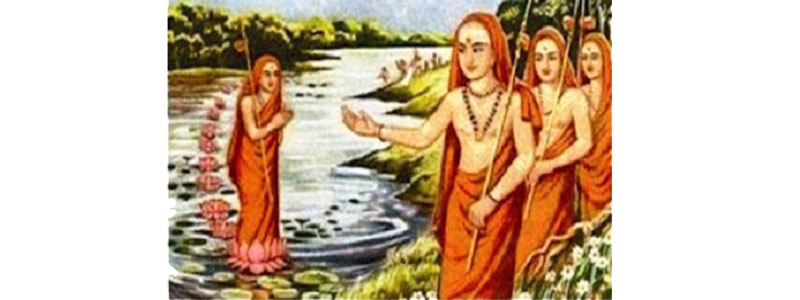
Lord Shiva meets Sri Sankara
Once, in Kasi, when Sri Sankara was going to the Vishwanath Temple, his path was blocked by an "untouchable" who was accompanied by his wife and 4 dogs. The disciples of Sri Sankara shouted at him to make way, and to keep a distance. The untouchable smiled and said, ""According to your principle of Advaita, which you practice, all the Jivatma are same as God. How do you ask me to go? How am I different from your Paramacharya? What you say is unreasonable. How can I go away from myself?" Sri Sankara realised that it was not an ordinary person and understood that it was Lord Shiva himself who had come along with His consort and the four Vedas. He prostrated before the Lord and sang five slokas called "Manisha Panchakam". Lord Shiva presented himself along with Visalakshi and blessed Sri Sankara.
Meeting with Vyasa Rishi
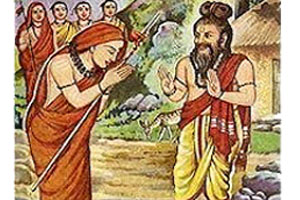
When Shri Sankara was 16, a very old Brahmin of ill health started arguments with him about Brahmasutra bashyam which Shri Sankara had written. Shri Sankara was astounded by his intelligence and arguments but they continued their discussion. The arguments continued for days together and the more Shri Sankara argued, his ideas crystallised more and more and he understood that the old man was none other than Vyasa Rishi, who was the creator of Brahmasutra. Sri Sankara said that he has done a great disrespect to the sage by entering into an argument. Vyasa Rishi said "I fully agree with your bashyam and I wanted to establish that yours is correct. I bless that you should live another 16 years and you should spread this Advaita throughout the country."
Meeting with Mandana Mishra
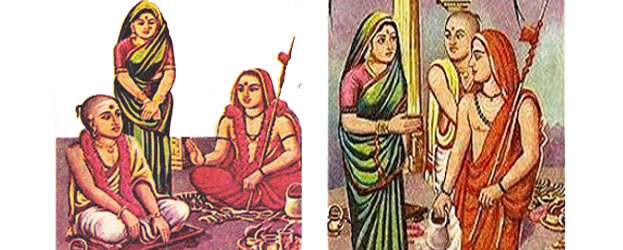
Sri Shankara learnt that there was a great learned person by the name Mandana Mishra who lived in Mahishmati and who followed the Karma Mimaamsa method of devotion. Sri Shankara arrived at his house and found his house was closed and Mandana Mishra was carrying out some rituals inside his house. Sri Shankara entered the house by using his powers. Mandana Mishra became very angry and shouted at Sri Shankara. However, Mandana Mishra admired the intelligence of Sri Shankara and started discussions with him after completing the rituals. Sri Shankara said that there should be a judge to decide the winner and suggested that Ubhaya Bharathi, the wife of Mandana Mishra, to be the judge. Ubhaya Bharathi, who was extremely intelligent and learned, realised that Sri Shankara was none other than Lord Shiva, did not want to declare her husband as the loser. She suggested that both of them should wear a garland of flowers and whichever garland fades first, that person would be the loser. Naturally, Sri Shankara won. As per the original condition, Mandana Mishra became an ascetic and started to leave the house. Unable to bear the separation, Ubhaya Bharathi stood transfixed and told Sri Shankara that according to our faith, the husband and wife, even though have two bodies, are spiritually one and she would be incomplete without her husband. Sri Shankara accepted this and started discussion with this lady. Ubhaya Bharathi showered questions like rain and Sri Shankara gave very beautiful answers and Ubhaya Bharathi acknowledged him, and followed Sri Shankara and her husband's footsteps. In their travels, they reached Sringeri in Karnataka, which is on the banks of Tunga. While Sri Shankara and Mandana Mishra were walking, Ubhaya Bharathi did not move and stood fixed in the sands of Tunga. Sri Shankara turned back and realised by his divine powers that Ubhaya Bharathi did not want to proceed any further and created a seat for her for spreading the Advaita. This seat is today called the Sharada Peetham or the Seat of Sharada. This was the first Mutt installed by Sri Shankara, with the direction that all the heads of the Mutts will be called Shankaracharayas and they will have a lineage of Shishyas or disciples.
Last rites of mother performed
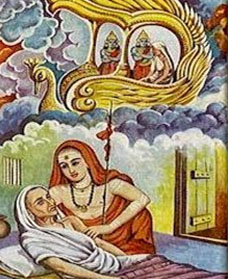
When Sri Shankara was in Sringeri, he divined by his superior powers that his mother was in her deathbed, and as per his promise while taking Sanyas that he would be by her side while she breathes her last, he reached Kaladi and paid his last respects to the old lady. Aryamba was happy that her son had come back. Sri Shankara prayed to Lord Venkateswara who appeared in person and blessed Aryamba. Sri Shankara did the last rites for his mother but the people of Kaladi said that a Sanyasi does not have the right to do the last rites, but he did not hear that and carried the body of Aryamba and put her in the pyre himself and lit it himself After the death of his mother, he went all over the country and converted the people of other faith to Advaita. He revived a number of temples and using his powers, he established a number of Yentras in these temples to spread the blessings of Parasakthi. During his travels, he arrived at Kolluru of Mukambika, a religious place in Karnataka. A poor brahmin came to Sri Shankara with his deaf and dumb son and prostrated before Sri Shankara. Sri Shankara asked the boy, "who are you?". The dumb and deaf child, for the first time, opened his mouth and explained, "The body is not me, it is the Paramatma who is my body." Sri Shankara was pleased with his answer and he gave an amla fruit and named this boy as Hastaaamalaka. (Hastaa means hand and Amalaka means amala). Hastaamalaka became one of the principle disciples of Sri Shankara.

Sri Shankara, with his three principle disciples, namely, Sri.Padmapada, Sri.Sureshwara (Mandana Mishra) and Sri.Hastaamalaka, went from place to place, and preached Advaita. Sri Shankara gave intense training to his disciples. One of the other disciples, Giri, while listening to the discourses, would not ask any doubts, would not open his mouth, and would be silent all the time. Some of the other disciples thought that this Giri did not know anything. One day, all the disciples were ready to listen to Sri Shankara's discourses. Sri Shankara waited for Giri to arrive. Ultimately, Giri turned up but instead of keeping silent on that day, burst forth into eight slokas which had never been heard by the disciples earlier. These were the creation of Giri. On hearing this, all the disciples felt ashamed andpraised Giri. These slokas are called "Thotakaashtakam". Giri was named as Thotaka by Sri Shankara.
Vishnu Pathathi Keshanta Stotra
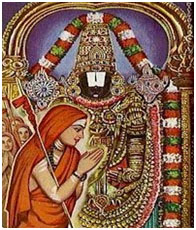
Sri Sankara visited Tirupathi and recited the Sloka "Vishnu pathathi keshanta stotra" which describes the Lord from his foot to the head. He wanted the people to visit the Lord in great numbers and get his blessings, he established an yantra. From that day the number of followers of the temple increased and is increasing day by day.

Rejuvenation of Badrinarayan temple
Sri Shankara completed his travels and went to Badrinath. Lord Vishnu appeared before him and told that his sculpture in Alaknanda river should be taken out and a temple should be built for it. This temple is called Badrinarayan temple and is one of the important religious places for Hindus. Once completion his mission, only at the age of 32, on Kartik full moon day in 820 AD, he left for Kailash to merge with the supremshankara (Lord Shiva) In the form of his works he is still alive; people across the world are being benefited by Adi Shankara making him eternal. The very fact that Hinduism is still a dynamic and all-encompassing religion stands as ample testimony to the deeds of Adi Shankaracharya. Apart from being the champion of Advaita philosophy, one of his invaluable contributions towards Hinduism was the reordering and restructuring of the ancient Sannyasa order. These Sannyasis help eternal code of life contained in the Vedas, still flows as the dynamic force underlying and unifying all humanity reach the masses.
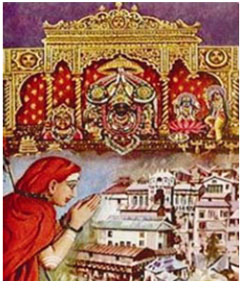
Books written by Adi Sankara
- A Bhasya on the Brahma Sutra.
- Bhashyas upon the Eisha, Kena Katha, Prasna, Mundak, Mandookya, Taittireya, Chandogya, Brihadaranyak, Nrsinhatapaneeya Upanishads and also the Shreemad Bhagwadgeeta and Sanatsujateeya commentary on the Brhadaranyaka Upanishad.
- 240 works of strotras like Upvansh Strotra, Vivekchudamani, Aparokshanubhuti and 80 contextual works.
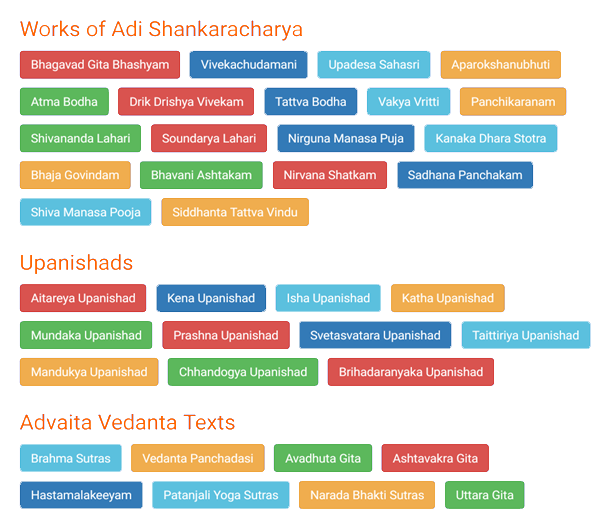
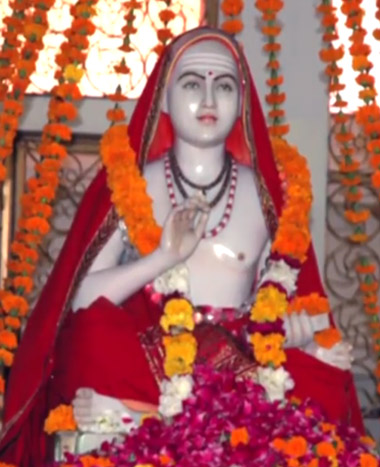
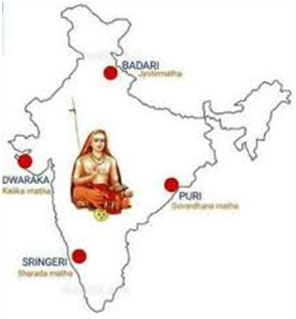
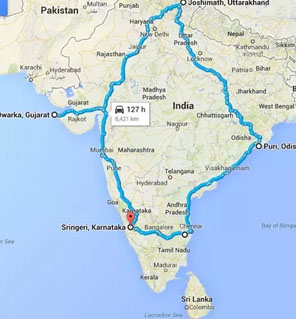
Four Major Mathas in Four Regions of India
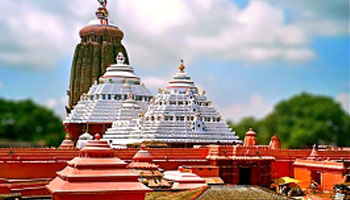 Govardhana Matha, Odisha – Rig Veda
Govardhana Matha, Odisha – Rig Veda
Govardhana matha is located in the coastal city of Puri in Odisha and associated with the Lord Jagannath temple. The Eastern part of the Indian subcontinent from Bihar to till Rajamundry and Orissa to Arunachal Pradesh,comes under this Math.
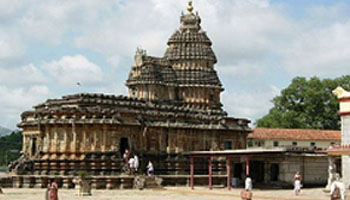 Sharada Peetham, Karnataka – Yajur Veda
Sharada Peetham, Karnataka – Yajur Veda
Sringeri Sharada Peetha was established by Adi Shankara on the banks of the Tunga River in Chikkamagalur district in Karnataka. Town of Sringeri is the site of the first Matha in India and one of the famous matha in South India.
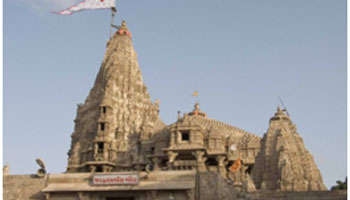 Dwaraka Pitha, Gujarat – Sama Veda
Dwaraka Pitha, Gujarat – Sama Veda
Dwaraka Matha is also called as Saradha Matha is situated in the ancient coastal city of Dwaraka in Gujarat. It is one of the four cardinal mathas established by Adi Shankara and associated with Dwarakadheesh Temple.
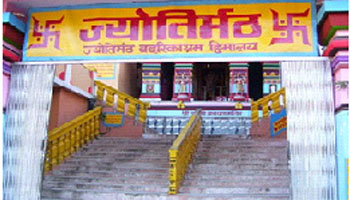 Jyotir Math, Uttarakhand – Atharva Veda
Jyotir Math, Uttarakhand – Atharva Veda
Jyotir Math or Jyotir Pitha is located in a city with same name Jyotirmath in Chamoli district of Uttarakhand. Jyotirmath is gateway to Himalayan mountains,trekking and pilgrim centres like Badrinath and Auli Ropeway, one of the longest ropeway in India.
The Shankara Peethams (Chatur Dhams)
| East | South | West | North | |
|---|---|---|---|---|
| Name of the Peetham | Govardhana Math | Sringeri Math | Kalika Math | Jyotir Math |
| Divinities | Puri (Orissa) | Sringeri (Karnataka) | Dwaraka (Gujarat) | Badrikashrama (Uttaranchal |
| Tirtha | Mahodadhi (Bay of Bengal) | River Tungabhadra | River Gomati | River Alakananda |
| Veda | Rig Veda | Yajur Veda | Sama Veda | Atharva Veda |
| Sampradaya | Bhogavala | Bhurivala | Kitavala | Nandavala |
| Mahavakya | Prajnanam Brahma | Aham Brahmasmi | Tattvamasi | Ayamatma Brahma |
| Titles to the Pontificial Seat | Aranya, Vana | All the titles, particularly, Saraswati, Puri, Bharati, Aranya, Tirtha, Giri, Ashrama | Tirtha, Ashrama | Giri, Parvata, Sagara |
| First Acharya of the Peetham | Sri Hastamalakacharya | Sri Sureshwaracharya | Sri Padmapadacharya | Sri Totakacharya |
Sringeri Sharada Peetham
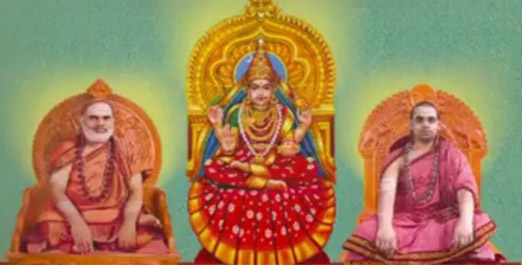
| Sl. No | Jagadgurus of the Sringeri Sharada Peetham | Period of Reign (CE) |
|---|---|---|
| 1. | Sri Shankara Bhagavatpada | 820 |
| 2. | Sri Sureshwaracharya | 820 – 834 |
| 3. | Sri Nityabodaghana | 834-848 |
| 4. | Sri Jnanaghana | 848 – 910 |
| 5. | Sri Jnanottama | 910 – 954 |
| 6. | Sri Jnanagiri | 954 – 1038 |
| 7. | Sri Simhagiri | 1038 – 1098 |
| 8. | Sri Ishwara Tirtha | 1098 – 1146 |
| 9. | Sri Nrisimha Tirtha | 1146 – 1229 |
| 10. | Sri Vidya Tirtha | 1229 – 1333 |
| 11. | Sri Bharati Tirtha | 1333 – 1380 |
| 12. | Sri Vidyaranya | 1380 – 1386 |
| 13. | Sri Chandrasekhara Bharati I | 1386 – 1389 |
| 14. | Sri Nrisimha Bharati I | 1389 – 1408 |
| 15. | Sri Puroshottama Bharati I | 1408 – 1448 |
| 16. | Sri Shankara Bharati | 1448 – 1455 |
| 17. | Sri Chandrasekhara Bharati II | 1455 – 1464 |
| 18. | Sri Nrisimha Bharati II | 1464 – 1479 |
| 19. | Sri Puroshottama Bharati II | 1479 – 1517 |
| 20. | Sri Ramachandra Bharati | 1517 – 1560 |
| 21. | Sri Nrisimha Bharati III | 1560 – 1573 |
| 22. | Sri Nrisimha Bharati IV | 1573 – 1576 |
| 23. | Sri Nrisimha Bharati V | 1576 – 1600 |
| 24. | Sri Abhinava Nrisimha Bharati | 1600 – 1623 |
| 25. | Sri Sacchidananda Bharati I | 1623 – 1663 |
| 26. | Sri Nrisimha Bharati VI | 1663 – 1706 |
| 27. | Sri Sacchidananda Bharati II | 1706 – 1741 |
| 28. | Sri Abhinava Sacchidananda Bharati I | 1741 – 1767 |
| 29. | Sri Nrisimha Bharati VII | 1767 – 1770 |
| 30. | Sri Sacchidananda Bharati III | 1770 – 1814 |
| 31. | Sri Abhinava Sacchidananda Bharati II | 1814 – 1817 |
| 32. | Sri Nrisimha Bharati VIII | 1817 – 1879 |
| 33. | Sri Sacchidananda Shivabhinava Nrisimha Bharati | 1879 – 1912 |
| 34. | Sri Chandrasekhara Bharati III | 1912 – 1954 |
| 35. | Sri Abhinava Vidyatirtha | 1954 – 1989 |
| 36. | Sri Bharati Tirtha | 1989 – Present |
| 37. | Sri Vidhushekhara Bharati | Successor - Designate |

The Greatest Revivalist of Hinduism
The very fact that Hinduism is still a dynamic and all-encompassing religion stands as ample testimony to the deeds of Sri Adi Shankaracharya.
About | Hostel & Students | Services / Activities | Membership | Gallery | Matrimony | Our magazine | Downloads | Contacts

